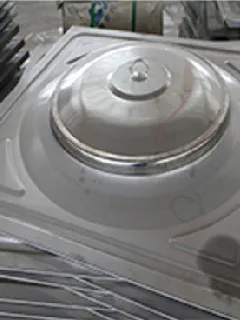loading...
- No. 9, Xingyuan South Street, Dongwaihuan Road, Zaoqiang County, Hengshui, Hebei, China
- admin@zjcomposites.com
- +86 15097380338
- Welcome to visit our website!
Advancements in Fiber Reinforced Polymer Bars for Construction Applications
Understanding FRP Reinforcement Bars A New Era in Construction
Fiber Reinforced Polymer (FRP) reinforcement bars have emerged as a transformative technology in the field of construction and civil engineering. As societies worldwide strive for stronger, more durable, and sustainable infrastructure, FRP bars are becoming a popular alternative to traditional steel reinforcement bars. This article delves into the properties, benefits, applications, and future potential of FRP reinforcement bars.
What are FRP Reinforcement Bars?
FRP reinforcement bars are composite materials made from a polymer matrix reinforced with fibers, commonly glass, carbon, or aramid. These materials are engineered to provide strength, stiffness, and corrosion resistance while being significantly lighter than traditional steel rebar. The unique combination of materials offers exceptional tensile strength and durability, making FRP bars ideal for various construction applications.
Benefits of FRP Reinforcement Bars
1. Corrosion Resistance One of the most significant advantages of FRP bars is their resistance to corrosion. Unlike steel, which can degrade over time when exposed to moisture and chemicals, FRP bars maintain their structural integrity in harsh environments, such as marine, chemical, or de-icing salt conditions. This quality extends the lifespan of structures and reduces maintenance costs.
2. Lightweight FRP bars are considerably lighter than steel, making them easier to handle, transport, and install. The reduced weight can lead to lower shipping costs and simpler handling on construction sites, thus speeding up the construction process.
3. High Strength-to-Weight Ratio The high strength-to-weight ratio of FRP reinforcement bars makes them particularly suitable for applications where weight is a concern, such as bridges and high-rise buildings. Engineers can design more efficient and safer structures without compromising on strength.
4. Design Flexibility FRP materials can be molded into various shapes and sizes, allowing for greater design flexibility. This characteristic is beneficial for complex architectural projects where traditional materials may limit design options.
frp reinforcement bars

5. Non-Magnetic and Non-Conductive FRP bars do not conduct electricity or create magnetic fields, making them ideal for applications in sensitive electronic environments, such as data centers or MRI facilities.
Applications of FRP Reinforcement Bars
The application of FRP reinforcement bars spans several sectors within the construction industry. They are used in the construction of bridges, parking garages, tunnels, and waterfront structures. Moreover, FRP bars are increasingly utilized in precast concrete elements, seismic retrofitting, and rehabilitation of existing structures.
One of the most notable projects utilizing FRP reinforcement is the construction of the “Franklin Avenue Bridge” in Minnesota. This bridge showcases how FRP can enhance durability and reduce maintenance needs, ultimately leading to cost savings over time.
Challenges and Considerations
Despite their numerous benefits, FRP bars also face challenges that must be addressed for wider adoption. The initial cost of FRP reinforcement can be higher than traditional steel, which may deter some project managers. Furthermore, the bonds between FRP bars and concrete are not as strong as those between steel bars and concrete, necessitating careful consideration during design and construction.
Future Potential of FRP Reinforcement Bars
As research progresses and technology evolves, the potential for FRP reinforcement bars is vast. Innovations in manufacturing processes can lead to reduced costs, while enhanced performance attributes can broaden their application range. Additionally, with increasing emphasis on sustainability in construction, FRP bars offer an eco-friendly alternative, given their long lifespan and reduced need for maintenance and replacements.
In summary, FRP reinforcement bars represent a significant advancement in construction materials, providing a range of benefits that cater to the evolving demands of modern infrastructure. While challenges remain, the future of FRP technology in construction looks promising as engineers and architects continue to explore its potential applications in building a more resilient and sustainable world.
-
The Rise of FRP Profiles: Strong, Lightweight, and Built to LastNewsJul.14,2025
-
SMC Panel Tanks: A Modern Water Storage Solution for All EnvironmentsNewsJul.14,2025
-
GRP Grating: A Modern Solution for Safe and Durable Access SystemsNewsJul.14,2025
-
Galvanized Steel Water Tanks: Durable, Reliable, and Ready for UseNewsJul.14,2025
-
FRP Mini Mesh Grating: The Safer, Smarter Flooring SolutionNewsJul.14,2025
-
Exploring FRP Vessels: Durable Solutions for Modern Fluid HandlingNewsJul.14,2025
-
GRP Structures: The Future of Lightweight, High-Performance EngineeringNewsJun.20,2025
